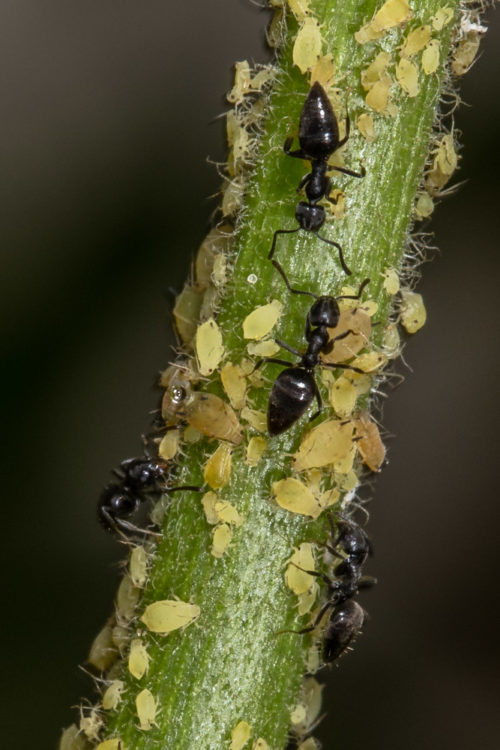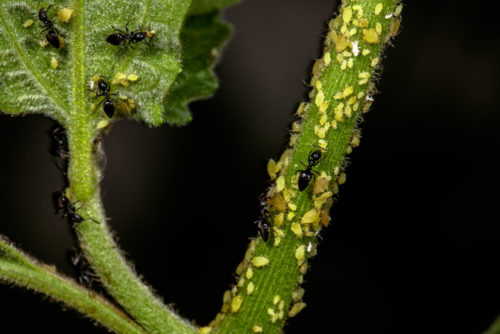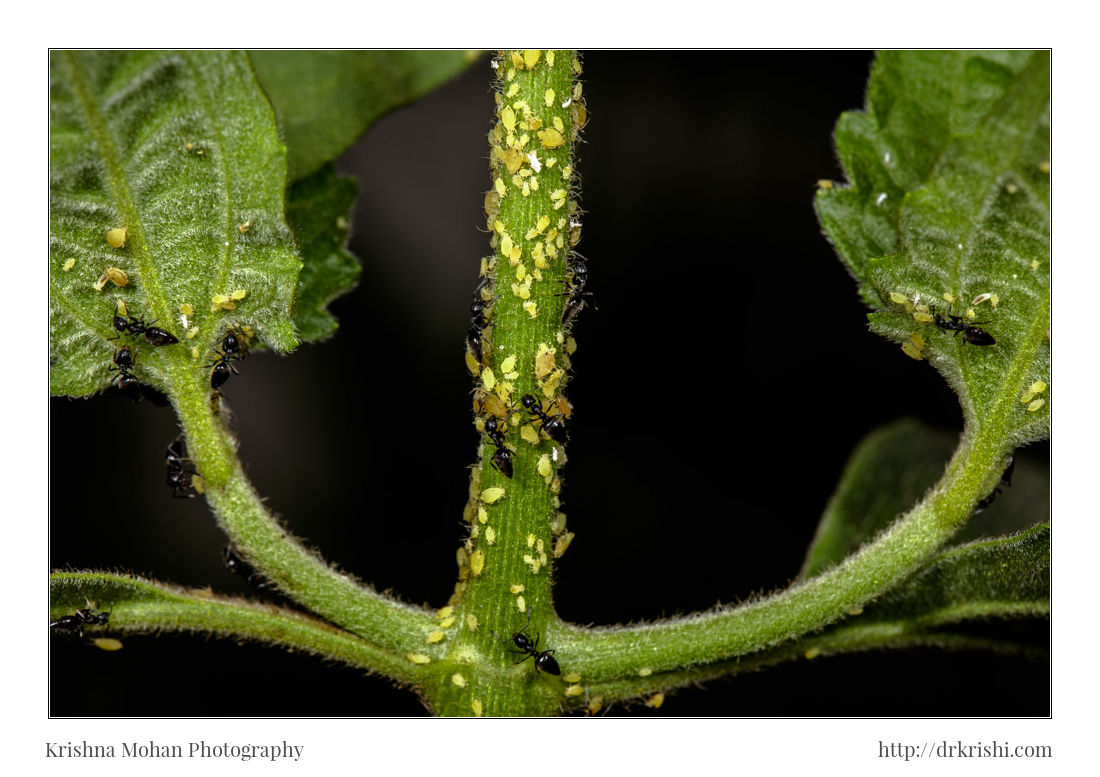
The relationship between aphids and ants is symbiotic in that both receive some benefit from the arrangement. Animals and plants in a mutually symbiotic arrangement with ants are called Myrmecophiles. I saw this group of White Footed Ants Technomyrmex albipes, on the plant tending aphids. Here I have used Canon EOS 5DS R coupled with Canon EF 100mm f/2.8L Macro IS USM and 56mm Kenko extension tube It was illuminated with Canon MT-24EX macro twin light flash.
Aphids are soft-bodied insects that use their piercing-sucking mouthparts to feed on plant sap. They usually occur in colonies on the undersides of tender terminal growth. Heavily infested leaves can wilt or turn yellow because of excessive fluid removal. While the plant may look bad, aphid feeding generally will not seriously harm healthy, established trees and shrubs.

Aphids feed on the sap of plants and secrete a substance called honeydew. You can check the above picture which shows a drop of Honeydew coming out of the aphid in the middle of the picture. This sticky sugary resin is a favourite food of ants, who actually “milk” the aphids for it by stroking their abdomen. That is why sometimes aphids are called “ant cows”.
Technomyrmex albipes, commonly known as the white-footed ant, is a species of ant first described in 1861 from Sulawesi, Indonesia by the British entomologist Frederick Smith. This is a small black ant, some 2 to 4 mm long with the lower part of the limbs pale. Workers are chocolate-black with pale lower limbs, antennae with twelve segments and a flattened petiolar node.

The white-footed ant is native to the Indo-Pacific area and has been introduced into Australia, Africa, North America, the Caribbean and parts of Asia. It inhabits dry forests and open locations. Tent-like nests are made out of the debris in trees, bushes, rotten logs, under rocks, in leaf litter and similar places. It also nests in man-made structures such as wall cavities and attics.

The white-footed ant forages widely, entering dwellings and scavenging in kitchens and other rooms where it is considered a pest. It is largely arboreal and feeds on the honeydew of sap-sucking insects such as aphids, mealybugs, and scale insects. For this purpose it protects the insects and drives off predators, thereby encouraging the insects which may be agricultural pest species; the mealybug Dysmicoccus brevipes, for example, transmits pineapple wilt disease in Sri Lanka, and biological control of the mealybug has proved difficult because of the activities of the ant. Similarly, in South Africa, the ant has encouraged outbreaks of the red scale insect (Aonidiella aurantii), a major pest of citrus in the country.

The unique relationship between these two organisms provides protection for the aphids and food for the ants. Ants protect aphids from predators, such as lacewings and ladybugs. Ants have also recently been found to safeguard the aphids from a fungal outbreak that causes death, by removing the bodies of the infected aphids. Anytime you see a large number of ants on a tree or plant; it is likely you have a large infestation of aphids. Not all species of ant find this arrangement beneficial, but many of the more common species do indeed farm them.
Chemicals on ants’ feet tranquilise and subdue colonies of aphids, keeping them close-by as a ready source of food. The ants have been known to bite the wings off the aphids to stop them from getting away.

It is a fascinating arrangement where aphids and ants on plants live in close cooperative proximity. Farmed ants supposedly produce larger drops of honeydew and more offspring. The sweet sticky stuff is a favourite food for ants, who also take it back to feed larvae. Plants, where there are aphids farmed by ants, may appear to be overrun by insects.
If you want to control aphid menace, then you can take anyone the following strategy. Managing ants are one way of controlling the aphid population. Ant bait stations are efficient because the ants take the bait and bring it back to the main colony. With fewer ants to defend them, aphid numbers will drop. A non-toxic method is to just wrap the plant or tree with sticky tape or netting which catches the ants and prevents them from tending to the aphids. In turn, the aphids get exposed to predators, and their numbers will dwindle. Conversely, you can focus your attention on the aphid population. Without aphids, the ants will be forced to move on for food. Horticultural soap sprays or neem oil work well for aphid control.

Check my earlier blogs on the same topic –


Your blog looks like a national geography channel. I really enjoyed..as i love nature and your blog has enormous content. Thanks so much for sharing this with me. Keep them coming.